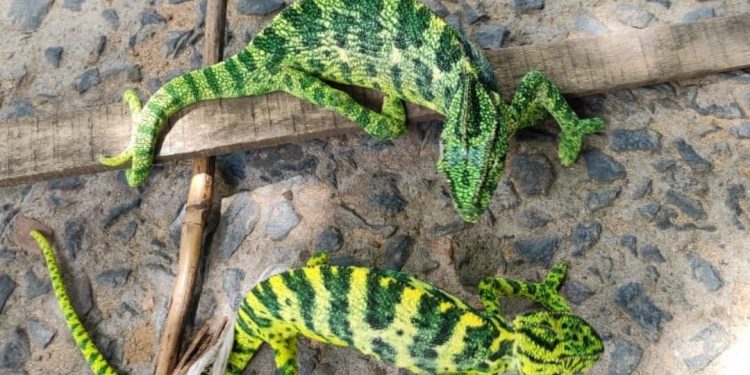Mahakalapara: Climate change, environmental pollution and rampant trafficking have posed serious threats to the chameleons residing in the saline mangroves and casuarina forests of Kendrapara district. The chameleons, known for their unique ability to change the colour of their skin, are found in large numbers in Kajalpatia saline forests under Batighar panchayat of this block. These species are mostly known for their distinct range of colours as they can alter the hues and brightness of their skin when they sense trouble or spot an enemy. Their skin turns green when they rest on green leaves, brown on sand dumps camouflaging themselves perfectly as per their environment. It is quite interesting to see that they even imitate the colour of a tree’s trunk while walking on them.
This quality is genetic as well as due to the release of some chemical substances in the skin which they do to catch their prey and adapt to the changing environment. They have another feature that no other animals can boast of. Their eyes can move independently of each other, enabling them to look in two different directions at once. These multi-coloured reptiles spread their population rapidly when they find their surroundings conducive for reproduction. They breed during the rains and winter and can be found in the saline mangroves and casuarina forests. These reptiles measure more than a foot in length and catch their prey by darting the tongue for over one foot. The insects and other small animals which it preys cannot escape from its mouth due to presence of sticky substance on its tongue.
However, their population has sharply declined in recent times due to climate change, discharge of toxic effluents and fumes from industrial plants. The reptiles were seen in large numbers before the 90s. However, their population witnessed a sharp decline after cyclonic storms like Super Cyclone in 1999, Phailin in 2013 and Hudhud in 2014 swept the district and the state. They also face threat from the poachers who catch them from the jungles and sell them to outside and international traders for a premium. The price of one of these reptiles is over Rs 1 lakh in the international market. This reptile has got value in international market for its leather and its use as a pet. The reptile is included in schedule-2 and part-1 as a rare species in the Wildlife Conservation Act-1972. There is provision of punishment if anyone is caught catching or poaching these reptiles.
Recently, Forest officials raided and arrested some youths when they were busy negotiating a deal to sell some chameleons. Environmentalists have demanded steps for the conservation and protection of this rare reptile







































